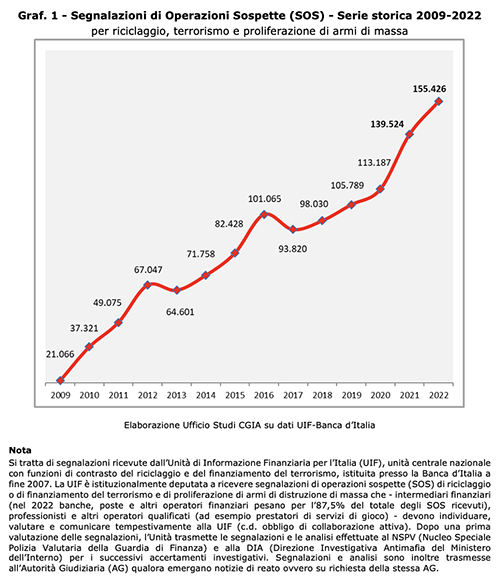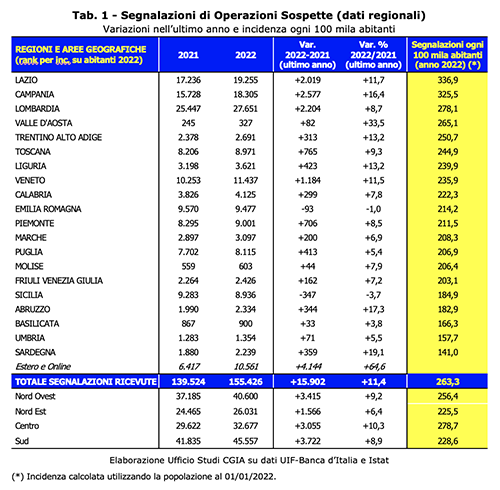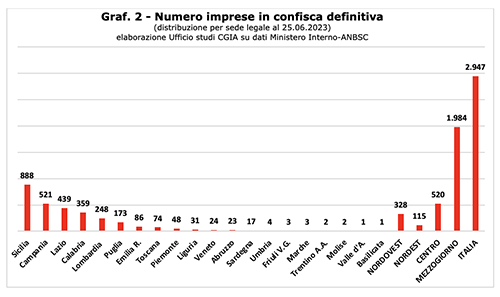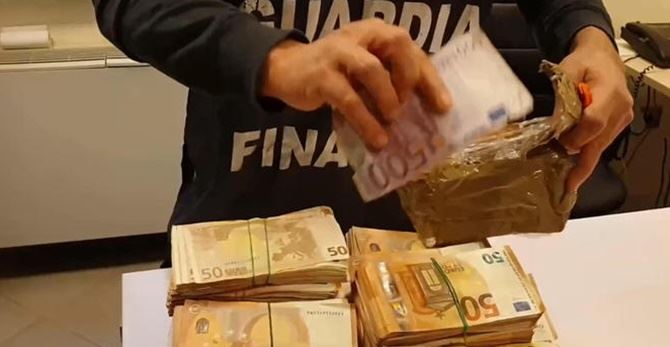SMEs increasingly targeted by the criminal economy
In 2022, the number of suspicious transactions (SOS) received by the Financial Intelligence Unit (FIU) of the Bank of Italy reached an all-time record of 155.426 reports (see Chart 1).

Furthermore, one in four was considered high risk, 99,8 percent of the total flow was attributable to the hypothesis of money laundering and in approximately 90 percent of cases the communications came from banks, post offices and financial intermediaries. (IMEL, SIM, insurance, trust companies, etc.).
This is what the CGIA Research Office says and raises the alarm: the danger that economic crime is creeping into our productive world is increasingly high. Not only. If the combination between the increase in interest rates and the decrease in bank loans to SMEs that occurred in the last year were to continue, it cannot be ruled out that the number of companies at risk of mafia infiltration is destined to grow further.
It should also be noted that among the main technical forms of transactions reported to the FIU, transactions with national bank transfers (31,3 percent of the total), with payment cards and electronic money (28,5 percent) and with money transfers ( 21,3 percent). The transactions reported following a suspicious transaction carried out with cash were only 5 percent of the total.
In addition to banks and post offices and financial intermediaries, by law also freelancers (notaries, accountants, lawyers, auditors, etc.), non-financial operators, gaming service providers (gambling houses, online gaming operators and in a fixed location, etc.) and the Public Administration have the obligation to report suspected money laundering or terrorist financing cases to the FIU. Once the acquired alerts have been evaluated, they are transmitted to the Special Currency Police Unit of the Guardia di Finanza (NSPV) and to the Anti-Mafia Investigation Directorate (DIA) for subsequent investigative checks. These reports are also sent to the Judicial Authority (AG), in case news of a crime emerges or at the request of the AG itself.
The turnover of crime is at least 40 billion
According to a prudent estimate drawn up by the Bank of Italy, the turnover of organized crime in Italy amounts to around 40 billion euros per year (practically 2 points of GDP)[1]. It must be taken into account, based on the definitions established at an international level, that this amount does not include economic proceeds attributable to violent crimes - such as theft, robbery, usury, and extortion - but only those originating from illicit transactions characterized by the agreement between a seller and a buyer. Such as, for example, smuggling, arms trafficking, clandestine betting, illegal waste disposal, gambling, receiving stolen goods, prostitution and the sale of narcotic substances.
Less intimidation, more acquisitions
Over the last 10 years, reports to the FIU have increased by more than 130 percent. If in 2012 there were just over 67 thousand, in 2022, as we reported above, they reached the record number of 155.426. In short, this explosion of communications indicates that criminal groups increasingly feel the need to reinvest the proceeds of their activities in the legal economy, also to consolidate their social consensus. And following the pandemic crisis, the mafias have changed the way they approach the business world. They are less inclined to use violent methods, such as intimidation or extortion, on the other hand they favor a more "commercial" approach, through the financing and/or acquisition of ownership of companies, exploiting their economic and financial vulnerability. In other words, the mafias increasingly offer themselves as real business service agencies (material supplies, administrative/tax consultancy, manpower, etc.); in doing so they begin to infiltrate the legal economy and last but not least have the possibility of reinvesting the proceeds of illicitly accumulated wealth.
The most at-risk situations in Milan, Rome, Prato, Naples and Crotone
At a regional level, Lazio (336,9 reports per 100 thousand inhabitants), Campania (325,5) and Lombardy (278,1) are the areas that received the highest number of reports in 2022 (see Tab. 1 ).

On a provincial basis, however, the most at-risk situations occurred in Milan (472,9 reports per 100 thousand inhabitants), Rome (404,8), Prato (388,2), Naples (386,9), Crotone (371,7 .366), Siena (335,5), Imperia (328,6), Trieste (303,4), Caserta (298,7) and Bolzano (XNUMX).
In general we can state that the areas most at risk at a national level are the large metropolitan areas (Milan, Rome, Naples and Florence) alongside the border provinces (Imperia, Trieste, Bolzano, Aosta) and the territories with of very worrying organized crime (Crotone, Caserta and Reggio Calabria). In addition to these trends, the specificities of Prato (strong presence of the Chinese community), Rimini (heart of seaside tourism) and Venice (port city, high tourist vocation and where the municipal casino is present) stand out.
Almost 3 thousand companies have been confiscated from the mafias
As of June 25th, the National Agency for the administration and destination of assets seized and confiscated from organized crime (ANBSC), reported that, in Italy, as required by Art. 48 paragraph 8 of the Anti-Mafia Code, the companies definitively confiscated from criminal associations have reached almost 3 thousand units. Over two out of three had their registered office in the South. The regions most affected by this measure were Sicily (888 cases), Campania (521), Lazio (439), Calabria (359) and Lombardy (248) (see Chart 2).

40,4 percent of the confiscated companies were active, 26,3 percent closed, 23,2 percent had insolvency proceedings underway and 9,9 percent were inactive. The most affected sectors concerned construction (22,6 percent of the total), trade (20,7 percent), accommodation and catering (9,7 percent) and real estate activities (7,9 percent) .
